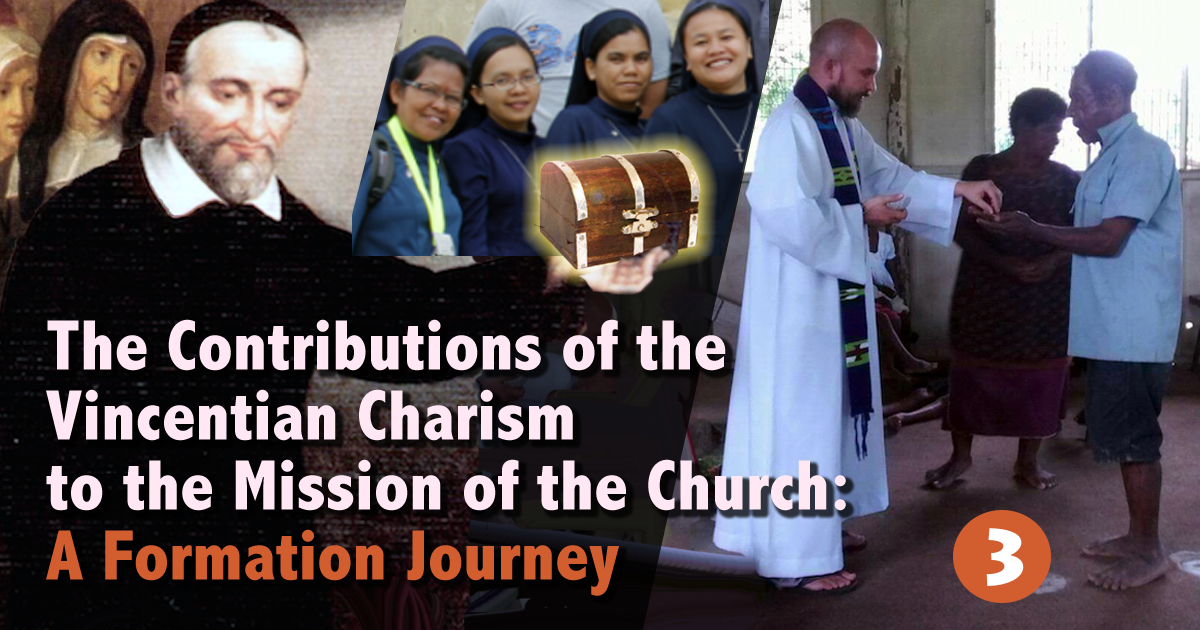This is the third of a series of formation packages meant for individual or group study which was introduced in “The Contributions of the Vincentian Charism to the Mission of the Church: A Formation Journey.” In that article, we also suggested a “Lesson Plan” for use in groups.

In earlier parts of the series we saw how an underlying intuition of Vincent and Louise seemed to be expressed in a structural change now recognized in church law as “societies of apostolic life.” Section two offered insights into what that looked like in the context of communities of women and men who committed themselves in private vows in contrast to the more formal vows of religious properly so called.
Even before their insights produced what would become our contemporary “Societies of Apostolic Life:” the charism birthed “Confraternities of Charity:” groups of women lay apostles, now known as the Ladies of Charity or the Association of International Charities (AIC). Here Delgado shows us the unfolding of the intuition of Vincent and Louise concerning a missionary and less clerical church.
Many have said that the present role of the laity in our church is the most enduring gift of Vatican II. As this lay association of women, and other lay movements (like the Society of St. Vincent de Paul) in succeeding centuries spread to virtually every country in the world their members continued to be defined with negatives even to the present day: “not vowed, non-ordained.”
“The biographers of Vincent de Paul [10] and Louise de Marillac [11] highlight their important contribution to the promotion of the laity, especially women. They also point out the various ways in which Vincent and Louise promoted the laity to take responsibility for their proper apostolate in the Church. The many impressive Vincentian accomplishments cannot be understood apart from the participation of so many lay persons, so many laymen and laywomen, in the mission [12].
As a result of Vincent’s lived experience in Châtillon and the establishment of the Confraternity in that place, and as a result of the essential collaboration of Louise de Marillac and other women who animated the members of the Confraternities in the rural areas, who brought together the Daughters of Charity and supported the Ladies … all of these experiences led to the development of multiple creative forms that enhanced and affirmed the participation of the laity in the mission of the Church. (See The Present and Future of the Vincentian Spirit)”
Lay people who were recognized as Saints fit into the awkward liturgical classification of “neither virgins nor martyrs” (nec virgine nec martyres”).
The Church’s Code of Canon Law defined the laity only by exclusion: a lay person is a Catholic who is not a member of the clergy. Heretofore, the laity were constricted to the role of paying, praying and obeying – even sharper in Italian: “Pray, pay and shut up!”
The Second Vatican Council Decree on the Laity was the result of a need to define the role of the laity within the church. When work began before the opening of the Council in the preparatory commissions, no conciliar theology of the laity was available. No council in 2,000 years had ever written a document on the laity.
So a document had to be written, especially since this council, in writing the Constitution on the Church, had just defined itself as the “People of God.”
The seminal idea that the church is a “sign and instrument” of God’s salvation being worked out in the world (LG 1); the truly radical notion that all Christians have a different but equal share in the church’s mission (LG, Chapter II; LG 32); the recognition that the “joys and hopes, the griefs and anxieties” of humanity are those also of the “followers of Christ” (GS 1); the move from an understanding of revelation as a set of propositions to a personal call to friendship (DV 2); and the great sensitivity to culture that inspired much of the reform of the liturgy (SC 37-40)—all of these and more are motivated by a spirit of evangelization and mission.
In the AIC we see a shift from a Church in which the clerical-religious element dominates to a Church with a more secular and lay character.
- What is my reaction to a church that is more secular and lay in character?
- What are the tensions I observe in thinking about mission of the laity in society today?
See you next week!
| View any or all of the Articles and SlideShares including today’s | |
| Download any or all of the SlideShares as PDF • PPTX |
We hope you’ve enjoyed this collaboration of…





0 Comments